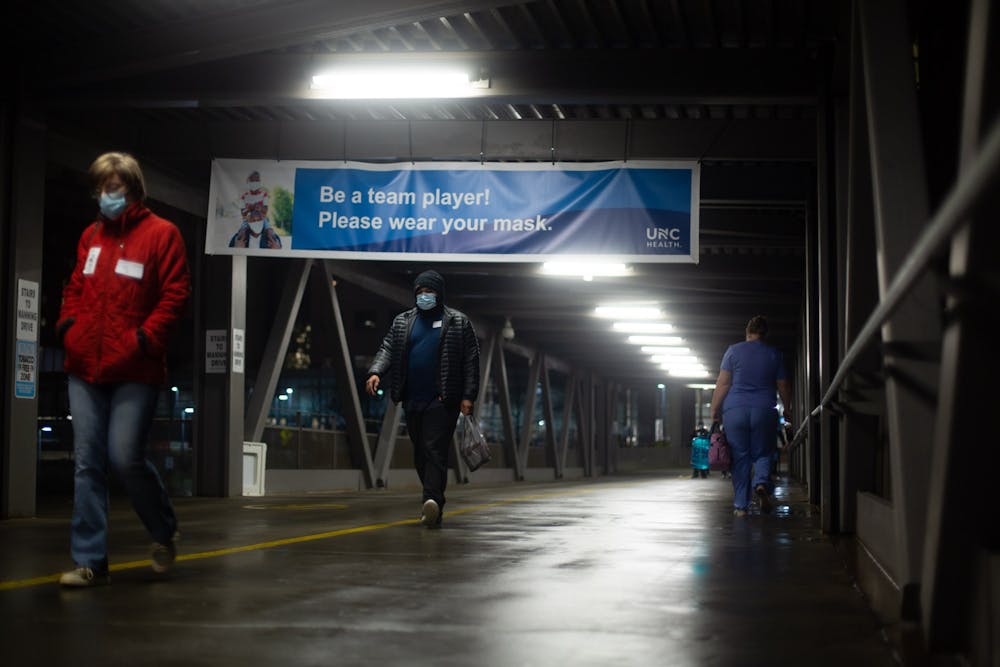Mehrotra said the pandemic has completely changed the way hospitals operate to ensure both COVID-19 and non-COVID-19 care can be provided safely. The process of putting on and taking off personal protective equipment has also added to the time it takes to provide care.
“You’ll see a lot of area hospitals, not just in UNC Health but across our region and across the state, hospitals are full,” Mehrotra said.
He also said a large part of the difficulties hospitals face are in the personnel department. He said there is a large demand for physicians, nurses, respiratory therapists and maintenance staff. Then, once these positions are filled, employees find themselves working long, difficult hours.
This is only worsened, he said, by the emotional toll of the job — with the prospect of putting their loved ones at risk every day, just by reporting to work, looming large over everyone’s heads. Yet, he said health care workers are still adamant about continuing to do all they can to fight the pandemic.
“The mental strain is there, but you don’t hear our physicians and our caregivers complaining about that, which is just amazing to see,” Mehrotra said. “What they’re asking for is ensuring that we have the appropriate safety equipment so they can provide the care.”
The response from state officials
In response to growing concerns due to rising case numbers and hospitalizations, state health officials doubled down on more aggressive measures in January to try to curb the spread of the virus.
On Jan. 6, Dr. Mandy Cohen, secretary of the North Carolina Department of Health and Human Services, issued a secretarial directive to address the deteriorating situation.
In the directive, Cohen urged North Carolinians to assume they have become infected with the virus if they've come in contact with individuals they do not live with, and to get tested. She also directed people to adhere to the state’s COVID-19 guidelines, urging them to stay home as often as possible, limit gatherings, wear masks and maintain physical distance (at least six feet) when in public.
Gov. Roy Cooper also extended the state’s modified stay-at-home order on Jan. 27, leaving it in place until at least the end of February. Under the order, North Carolinians are required to remain in their homes from 10 p.m. to 5 a.m.
In a press release that day, Cooper said North Carolinians need to adhere to state restrictions and keep taking the threat of the virus very seriously.
“With more than 3,300 people in the hospital, and the percent of positive tests in double digits, we know this virus is still spreading,” Cooper said. “And with at least one new contagious variant of COVID-19 in our state, we still have work to do. We cannot let our guard down, especially in these cold winter months.”
To get the day's news and headlines in your inbox each morning, sign up for our email newsletters.
Weary but willing, health care workers fight on
Despite the discouraging start to the year, there is optimism in the health care community about how the pandemic is being handled.
Bailey Pennington, a communications specialist at the NCDHHS, said in an email that the department is taking a proactive approach in handling the most recent uptick in cases.
She said the NCDHHS has adopted different strategies to assist health care systems amid the surge in COVID-19 hospitalizations, with facilitating coordination between health care systems across the state and the State Emergency Response Team being chief among them.
She also said the NCDHHS is implementing plans to support the movement of patients across a health care system, or into alternate care sites if needed, while also providing alternate care sites if physical hospital space is too full.
Though she acknowledged the worrying statewide trends, she said the state’s efforts to combat them have made a difference.
“These strategies have been successful,“ Pennington said in the email. “The communication and collaboration across the healthcare system in North Carolina has been key to ensuring support is available for facilities when needed so they have the necessary resources to care for patients and there is additional awareness across the healthcare system when facilities need additional support.”
Mehrotra shared the sentiment, saying the NCDHHS and the Orange County Health Department have been doing a great job in terms of transparency. Knowing exactly what’s happening and when, he said, has been incredibly helpful in the process of providing care.
He also said the state has been doing well at providing resources and PPE to hospitals, but that more testing equipment is still needed.
The start of the vaccine rollout did make him hopeful — but he said the state won't see a significant enough impact until at least late spring, so people shouldn’t let their guard down. For now, he said the best thing people can do is to keep wearing masks, keep physical distance in public and to get vaccinated when it is their turn.
“We look forward to being on the back end,” Mehrotra said. “We see a light at the end of the tunnel and we’re just waiting to get there.”
@GMolero1
@DTHCityState | city@dailytarheel.com




